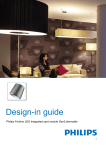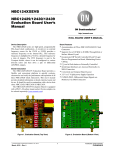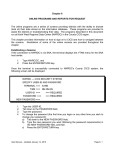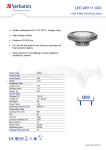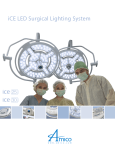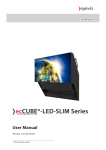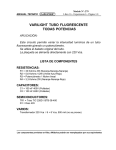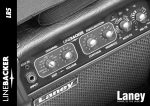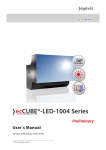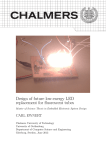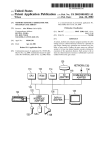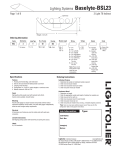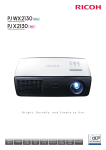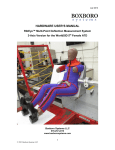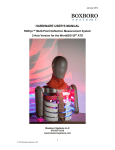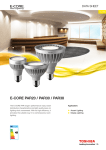Download Design-in guide
Transcript
Design-in guide Philips Fortimo LED Disk 800lm Gen3 dimmable 1 Contents Introduction 3 Designing luminaires 3 Applications Difference between Gen 1 and Gen 2 3 4 Basic information of the module 5 Structure Product range 5 5 Nomenclature of the Fortimo LEDDisk 800lm Gen3 System approach 6 6 Recommendations 6 Optical design Installation Points of attention 21 21 Noise Dimmerlist 21 22 Norms and Standards 23 23 23 23 Photo biological safety aspects UV and IR radiation 23 24 Electromagnetic compatibility Humidity 24 24 Exposure to direct sunlight Vibration and shocks 24 24 11 IP codes, dust and moisture protection Glow-wire test 24 25 12 End-of-life behavior Disposal 25 25 7 Beam Angle Spectrum 7 7 Light distribution Make use of diffuser foil 8 8 Secondary optics Color consistency 9 9 General 12 Fixation Sticker 12 13 Electrical design General 20 20 Approval Environment 7 Mechanical design 20 General Rules to calculate the LED load Safety Minimum and maximum flux Lumen maintenance Dimming 14 14 Characteristics of the driver 14 Starting Characteristics 14 Class I and II Inrush current 14 15 Thermal design 16 General 16 Test requirements Critical measure point 16 16 How to measure Tc Thermal Interface Material 16 17 Complementary heatsink partners Heatsink design 17 18 Thermal model Thermal Calculation 18 19 Thermal resistance 19 2 Introduction Thank you for choosing the Philips Fortimo LED Disk 800lm Gen3 module. In this guide you will find all relevant information to design new luminaires based on this module. More information or support If you require any further information or support please consult your local Philips office or visit: • Fortimo modules www.philips.com/fortimo • General OEM info www.philips.com/oem Designing luminaires based on the Fortimo LED Disk 800lm Gen3 module The use of LEDs brings additional considerations for luminaire manufacturers compared with traditional lamps. For example, how can you ensure that your new luminaire can take advantage of LED improvements without having to redesign it each time? Also, how do you ensure that your new luminaire has a sufficient heat sink, and how do you deal with variations in flux and/or color. Fortunately, the Fortimo LED Disk 800lm Gen3 module addresses these issues to ensure easy adoption of LED technology for lumen packages of 800 lm. The Fortimo LED Disk 800lm Gen3 module is designed for easy integration in luminaires, thanks to the integrated driver and optics. It allows a fast time to market. The Fortimo LED Disk 800lm Gen3 is ideal for compact downlights requiring high quality light, thanks to the latest energy efficient LED technology, integrated driver and optics. Other applications can be explored by OEMs as long as this does not create a design conflict with the LED Disk Gen2.0 Module system and European/Chinese/Indian or other countries’ luminaire standards are respected (EN 60598). Complementary partners, especially for heat-sink and reflector design, are now also developing products around Fortimo LED Disk 800lm Gen3 Module systems. In this application guide you will also find references to heat sinks (passive cooling) and reflector. . Applications The Fortimo LED Disk 800lm Gen3 module is intended for general lighting applications in semi professional markets such as: • Hospitality, healthcare and cruise ship applications: corridors, service, areas, lobbies, lounges, restaurants, reception areas, waiting rooms • Home applications: fixed, recessed, pendant and ceiling luminaires, • Retail applications: shop windows, corridors, changing rooms, toilets 3 • Office applications: corridors, meeting rooms Other markets can be addressed only if the relevant luminaire regulations are respected (e.g. EN60598). Furthermore, the LED Disk 800lm Gen3 module has no IP classification, so if you would like to develop a Fortimo-based luminaire for outdoor use, you are responsible for proper IP protection and approbation. Also, consult us if you wish to deviate from the design rules as described in this guide. Future advances in bare LED efficacies will be incorporated into the Fortimo LED Disk 800lm Gen3 module. Which means you can take advantage of increasing efficacies, without changing the dimensions, shape of the module. This is a future-proofed approach to enables you to plan and design new luminaire ranges that can be marketed (without redesign) for years to come. Difference between Fortimo LED Disk 800lm Gen3 module Gen2 and Gen3 Gen 2 - Topside: Silver Philips Logo Diffuse lens Gen 3 - Topside: White* No Logo Transparent efficient lens 2CCT: 2700K, 4000K 3CCT: 2700K, 3000K, 4000K Non dimmable Dimmable (LE) Good efficacy More than 25% efficacy upgrade * OEM can put a sticker on this side to change the color to silver if needed. 4 Basic information of the module Structure of the Fortimo LED Disk 800lm Gen3 module The LED Disk module consists of 5 main components: Heat spreader MCPCB with LEDs mounted Driver PCB Lens Housing (plastic) Product Range Fortimo LED Disk 800lm Gen3 module has 3 variants in color temperature. They all have a white housing. Product Name Fortimo LED Disk 800lm/827 dim G3 Fortimo LED Disk 800lm/830 dim G3 Fortimo LED Disk 800lm/840 dim G3 5 Nomenclature van de Fortimo LED Disk 800lm Gen3 module The names of the modules are defined as follows (ea): Fortimo LED Disk 800lm/827 dim G3 Fortimo : our brand name for efficient, clear & reliable lighting : LED Disk : downlight module with integrated optics and driver 800 lm : 800 lumens 827 : 8 for color rendering index of 80, 27 stands for the CCT of 2700K dim : the module is dimmable G3 : indication of the generation System approach The Fortimo LED Disk 800lm Gen3 module is designed as a total LED system containing LEDs, driver and optical lenses. The system is integrated in a fitted compact housing. Matching heatsink is design by complementary partners and can be assembled to the backside of the module via 3 screws. To operate the module, a power of 230 VAC needs to be applied via the input wires of the module. Recommendations The general recommendations for luminaire design given by the IEC (IEC 60598) and the national safety regulations are also applicable to LED-based luminaires. The Fortimo LED Disk 800lm Gen3 module does not require special ESD measures in a production environment. The Fortimo LED Disk 800lm Gen3 module is Class I and Class II and can be used in luminaires with according classes. The Fortimo LED Disk 800lm Gen3 module has no classification. If an OEM decides to use the system in a luminaire for outdoor application, they shall be responsible for proper IP protection and approval of the luminaire. Designing a luminaire around the LED module requires a good thermal contact between the module and the luminaire to maintain the correct effect of LED- cooling (by the heatsink). 6 Optical design The Fortimo LED Disk 800lm Gen3 module has a beam angle shape 85 degree, (see polar diagram / intensity diagram) which is a starting point for secondary optic design by OEMs. Ray set files are available upon request. Secondary optics is not part of the Fortimo LED Disk 800lm Gen3 offering. This is an added value area for OEMs, and it is up to the OEM to decide whether secondary optics is needed depending on the end application. Minimum and maximum flux (lm) per type LED Disk 800lm Min flux Typ flux Max flux 2700K 720 800 880 3000K 720 800 880 4000K 765 850 935 Gen3 Note that the optical parameters included in this guide such as color points x and y, CRI and luminous flux etc. are measured in an integrating sphere. Beam Angle (degree) for all types Min Typ Max 80 85 90 Spectrum of LED Disk 800lm Gen3 Module 7 Philips Fortimo LED Disk 800 lm Gen3 module light distribution Fortimo LED Disk 800lm Gen3 2700K Fortimo LED Disk 800lm Gen3 3000K Fortimo LED Disk 800lm Gen3 4000K Make use of a diffuser foil It is possible to make the lens more diffuse by using a thin diffuser foil in front of the lens. When it comes to diffusers there is always a trade-off between how well the diffuser can hide the LEDs and how much light can pass through the diffuser. If requested, this foil can also change the shape of the beam, depending of the type of foil. Type Option Symmetric Medium Angle 6060 Angles T% Haze 60°x60° 89 100 Clarity 2.7 Depending on the holder and required beam angle you can choose a different angle. See pictures of the LED Disk with and without the described foil. Without foil With foil and holder Secondary optics 8 The 85° beam angle shape (see polar diagram / intensity diagram) is a starting point for secondary optic design by OEMs. Ray set files are available upon request. The secondary optic design should not cover the exit aperture. The aperture diameter is 39.6mm. Secondary optics are not part of the Fortimo LED Disk 800lm Gen3 offering. This is an added value area for OEMs, and it is up to the OEM to decide whether secondary optics are needed depending on the end application. The OEM can develop his own reflector concept. Meanwhile, complementary partners have developed compatible reflectors for the Fortimo LED Disk 800lm Gen3 modules. See example, a reflector of the supplier Nata, specific developed for our module. There are other suppliers that are developing products for our module. Reference to these suppliers does not necessarily mean they are endorsed by Philips. Philips gives no warranties regarding these products and assumes no legal liability or responsibility for any loss or damage resulting from the use of information given here. Complementary reflector partner NATA www.nata.cn Color consistency (SDCM) The current specification of the Fortimo LED Disk 800lm Gen3 modules (2700K, 3000K, 4000K) for color consistency is 5 SDCM @ 0-hours. SDCM stands for Standard Deviation of Color Matching and the value 5 refers to the size of an ellipse around the black body locus. Staying within this ellipse results in a consistency of light whereby there is no perceivable difference from one luminaire to another. 9 Lumen maintenance 10 FORTIMO LEDdisk 800lm Gen3 Module has a lifetime of 50,000 hours defined as (L70,B50), where: - L70,B50 meaning 50% in total of whole population of lamps either fail without light output or lumen maintenance lower than 70% of initial value. - Lifetime based on temperature of the module must be within specifications, Tc < 60°C @ Ta = 35°C (50.000Hrs) (see Table) Lifetime estimation is based on the application environment condition of 35°C, burning in a simulated in-luminaire condition: the heat produced by the LED module in the luminaire (or similar housing) must be dissipated to the surroundings. If a luminaire is physically insulated by a ceiling, wall or insulation blanket, the heat produced cannot easily be dissipated. This will result in the LED module in the luminaire heating up, which can have an adverse effect on system performance and lifetime. For optimum performance and lifetime it is important that air can flow freely around the luminaire: this airflow through the luminaire, around the modules, has a positive effect on temperature control and hence on performance and lifetime. The lifetime estimation is also based on 2 cooling down switching cycles a day and using the rated voltage and current. L70B50 25000 Hrs Tcase < 70 °C Ta < 35 °C 40000 Hrs Tcase < 65 °C Ta < 35°C 50000 Hrs Tcase < 60 °C Ta < 35°C . 11 Mechanical design General The LED Disk 800lm Gen3 module contains 4 basic blocks: • LIGHT : MCPCB with LEDs mounted (internal) • OPTICS : 1 lens • ELECTRIC : Integrated Driver (internal) • MECHANICS : Plastic Housing Mechanical fixation The Fortimo LED disk 800lm Gen3 module has 3 tapped holes on the bottom plate of the module. These screw holes (same position as Gen1 and Gen2 – NO 3x 120degrees) can be used to fixate the module in a luminaire or on a heatsink. Use M3 screws length depending on the chosen solution, with a max torque of 5 Nm. 12 It is not allowed to drill a hole into the module or to open the module (no warranty ). The PHILIPS brand logo is printed on the side of the white housing, positioned above the wire. Sticker The top view of the housing is also white. To create a similar look as the Gen1 and Gen2 (silver top), the OEM can put a silver colored sticker on top of this housing. See dimensions of a possible sticker that can fit the topside. . 13 Electrical design General The LED Disk 800lm Gen3 module has an integrated driver, the user doesn’t need to connect external driver. The mains supply, Line (brown) and Neutral (blue), must be connected to the power supply. The length of the cable is 250mm. If earth connection is needed, make sure that a metal connection is made with the backside of the module. A strength relief must be added to prevent large pull force on the wires. Characteristics of the driver Name Value Unit Remarks Voltage 220~240 V AC Frequency 50~60 Hz Current @230V AC 50HZ 55 mA Power factor 0.9 THD @ 220V/230V 32 Typical Min % Max Starting Characteristics The module can be switched on in milliseconds, which is a general characteristic of LEDs. Class I and II The module is a Class I and Class II product. A class I product is safe due to the connection of the protective earth to the luminaire. All 14 materials that can conduct electricity should be connected to the protective earth. In a Class II product the driver design is such that in the event of single fault conditions the mains cannot come into electric contact with the electrically conductive parts of the luminaire. Luminaire Class I Class II Module Class I Module Class II Module class I & II (e.g. Integrated spot) (e.g. LEDisk module gen1,2) (e.g. LED disk Module gen3) ok EMI issues possible ok ok ok Safety and EMI issues possible Inrush current The current that flows during the system the very first milliseconds when switching on a luminaire or an entire lighting installation, is called the inrush current. The important parameters are the current peak and current width at that moment, for making the correct choice of switch gear and fusing e.g. circuit breakers, miniature circuit breakers. Name Max modules Inrush current Inrush current half on MCB peak (A) time width (us) 40* 1,4 93 Fortimo LED Disk 800lm Gen3 . *Depending also on the maximum modules you want to put in 1 dimming circuit. . 15 Thermal design General For optimum performance the Fortimo LED Disk 800lm Gen3 module must operate within specified temperature limits. But because there is no over-temperature protection in the module, a cooling methodology must be applied.. Test requirements Temperature measurements should only be performed when the luminaire is thermally stable, which may take 0.5 to 2 hours, depending on the thermal capacity of the luminaire (see also the relevant clauses in IEC 60598). For all measurements such as temperature, luminous flux and power, a stabilization period of at least half an hour must be allowed before any reliable data can be obtained. Measurements must be performed by means of thermocouples that are firmly glued to the surface (and not, for example, secured with adhesive tape). Critical measurement point For LEDs the junction temperature is the critical factor for operation. Since there is a direct correlation between the case temperature and the LED junction temperature, it is sufficient to measure the bottom of the module. The critical point is on the rear surface of the LED module. If the case temperature (Tc) at the critical measurement point is too high (exceeding the recommended maximum temperature), the performance of the LEDs will be adversely affected, for example in terms of light output, lifetime or lumen maintenance. Tcase is defined < 70°C @ Tambient max 35°C (25000 Hrs) or < 60°C @ Tambient max 35°C (50000 Hrs) The absolute maximum Tcase temperature is 100°C, increasing this temperature will severely influence the lifetime and performance. How to measure the critical temperature point Tc The Tc temperature can be measured by making a thin V-groove on the heatsink. (see also the relevant clauses in IEC 60598). Measurements must be performed by means of thermocouples that are firmly glued to the 16 surface (and not, for example, secured with adhesive tape). Be sure to measure the temperature of the bottom metal part of the module and not the TIM (thermal interface material) or the heatsink. Thermal Interface Material (TIM) To reduce thermal impedance between the module and the heatsink, thermal paste can be used (attention be careful with the quantity) or thermal pads. This material replaces air, which is a thermal insulator, by filling the gaps (see picture) with material that has better thermal conductivity. In general, thermal paste performance better then thermal pads. Recommended thermal interface partners are : Laird Technologies The Bergquist Company Complementary heatsink partners There are suppliers that have developed heatsinks for our module. Reference to these suppliers does not necessarily mean they are endorsed by Philips. We did thermal testing (on Tc 70°C @ Tamb 35°C) with the heatsinks of the included suppliers (the offered heatsink for LED Disk 800lm is ok for the LEDdisk 800 gen3) Philips gives no warranties regarding these products and assumes no legal liability or responsibility for any loss or damage resulting from the use of information given here. Complementary heatsink partners AVC (also available in white) Wisefull Sunon www.avc.com.tw www.wisefull.com www.sunon.com Heat-sink design To ensure that housing temperatures do not exceed the specified maximum values, a luminaire can act as an additional heat sink. The applicable heat transport mechanisms are 17 conduction via the heat sink and convection and thermal radiation to the surroundings. The objective of this chapter is not to indicate exactly how to calculate a heat sink, but to give some guidelines on how to improve its performance. Although a heat sink can have many (complex) shapes, the following discussion is based on a disk type of heat sink. The results for square plates, etc., are more or less the same provided the surface areas are equal. The Material W/mK Copper 400 Aluminum 200 Brass 100 Steel 50 Corrosion-resistant steel 15 type of material used has a relatively large influence on the final result. For example, a comparison of the thermal conductivity (k) of copper with that of corrosion-resistant steel (see table left) shows that a substantially smaller heat sink can be made with copper. In practice the best material for heat sinks is (soft) aluminum. The thickness (d) of the heat-sink disk is also of major importance. Assuming the use of different heat sinks of the same diameter but made from different materials, the same effect in terms of temperature difference will be achieved if the product of thermal conductivity (k) and disk thickness (d) is constant. This means more or less the same result is obtained with a disk of 1 mm copper, 2 mm aluminum, 4 mm brass, 8 mm steel or 26 mm corrosionresistant steel. Increasing the diameter, and thereby also the surface area, of the heat-sink disk also leads to an improvement, but the effect is smaller for larger diameters and depends on the thermal conductivity (k) and thickness (d) of the material. Thermal radiation can also form a substantial part of the total heat transfer, and is of the same order as for convection. This depends strongly on the emission coefficient (see table) of the surface, which lies between 0 and 1. For example, a polished aluminum surface has a very low emission coefficient, while that of a painted surface is very high. For passive cooling a high emission coefficient is preferred. Material Surface Emission coefficient Aluminum New/polished 0.04 – 0.06 T Oxidized 0.2 – 0.3 h Anodized 0.8 e Steel Painted 0.8 – 0.95 New/polished 0.03 – 0.07 Heavily oxidized 0.7 – 0.8 r m a l model The drawing below shows a thermal model that can be used to determine the required thermal performance of the cooling solution for the LED module. 18 Thermal calculation Thermal Ohm’s law: gives the relationship between temperature difference, thermal power of the module and thermal resistance of the ΔT = Pth x Rth heatsink Required thermal resistance of the heatsink: Attentionpoint = the max difference between Tc and Tamb may not exceed 35°C Rth = (Tc-Tamb)/ Pth Thermal Resistance @ Tamb 35°C of the heatsink CCT Thermal power (W) Rth 2700K 7,4 < 4,7 3000K 7,4 < 4,7 4000K 7,3 < 4,8 Passive cooling systems are based on the fact that hot air moves upwards, thus creating an airflow along the surface. This is called natural convection. Consider this airflow, the shape and position of the heatsink will affect this flow. The fins should be ideally parallel to the direction of the flow. Limit the number of thermal interfaces between the module and the ambient Making use of thick fins conducts better then thin fins. Large spacing between fins is better than small spacing. Thermal radiation is important, anodized or power coated surfaces are more preferable to blank surfaces . 19 Dimming General The Fortimo LED Disk 800lm Gen3 module dimming platform works according the AM (amplitude modulation) protocol. Thanks to the use of an amplitude and not pulse width modulation protocol, the system becomes up to 30% more efficient when dimmed. There are two main AM dimming methods today; Trailing edge (TE) and Leading edge (LE) dimming. To be prepared on the SSL7 (Zhaga dimming compliant), we choose LE dimming. Leading Edge Dimming means that the early part of each sine half wave is chopped off Suitable for - resistive loads (ordinary incandescent lamps, high voltage Halogen, etc.), marked with „R“ - inductive loads (Coils, low voltage halogen with conventional transformer, etc.), marked with „L“ This method is most compatible with legacy dimmers what results in better total cost price. Also most of the installations can be maintained with minimum correction. Rules how to calculate the LED load Because a LED Module is not a resistive load we have Philips Lighting Design Rules. 1. Incandescent Dimmer. 10% of Rated Dimmer Power is considered OK Only performance (dim-level, flicker) needs to be proven. More loading can be allowed: If it can be proven that the LED Load does not cause overheating in the dimmer. 20 If it can be proven there is no over-stress on the dimmer components. Up to 25% of Rated Dimmer Power is used in practice 2. LED Dimmers: Can be loaded with LED Power specified by the Dimmer manufacturer (see manual dimmer) 3. Universal Dimmers: Rules depend on dimmer operating mode (see manual dimmer) Installation Legacy dimmers usually are connected in the L-wire of the mains, so like a normal single pole switch. Some new LED or universal (intelligent) dimmers require also the connection of the neutral wire to supply the dimmer. Points of attention - Check the minimum load of a dimmer, this can be a root cause of bad performance - For specific LED and/or CFLi dimmers check the user manual for maximum load (often these dimmers are already de-rated) - Check if the dimmer has a thermal protection that shuts down the dimmer in case of overload. Some dimmers have an automatic protection, some have a non-resettable (so basically the dimmer gets broken, but safe) or no protection. - Dimmer manufacturers that mention Philips LED compatibility can mention the compatibility with LED-lamps instead of LED modules, verification is needed. - Some dimmers have an additional screw trimmer to adjust the lowest level without flickering, so lowest possible dimming level can be different depending on the conditions - Mixed load: Combination of DL modules with other lamps, drivers etc. is not tested and not guaranteed. Noise The audible noise measurements are executed according to 'ISO 3741:1999 “Acoustics Determination of sound power levels of noise sources using sound pressure - Precision methods for reverberation rooms”. Our limit is < 25 dBA. Dimmerlist We tested the Fortimo LED Disk 800lm Gen3 module on compatibility with a range of dimmers. The dimming performance is depending on the type of dimmer and grouped in 3 categories. 21 Brand Type # Type Max Load* Min # modules per dimmer** Dimming performance Lowest light level C rabtree DV21912 67084 67081 KARRE 2247u 310-01901 6523U 20160 RS16/400 P400 2250U 2200U 506da109 283010 030200/100 225 NV DE 435HAN CCTEL11013 2866-10 09-013 RL 400W 1 RLC 400W 1 RL 300W 2 RL 600W 2 RL 500W 1 LED 200W 1 LED 100W 1 RL 500W 1 RLC 400W 2 RL 400W 2 1 - 10 % 1 - 10 % 1 - 10 % 1 - 10 % 1 - 10 % 1 - 10 % 1 - 10 % 1 - 10 % 1 - 10 % 1 - 10 % 11 - 20 % 11 - 20 % 11 - 20 % 11 - 20 % 11 - 20 % 11 - 20 % 11 - 20 % 11 - 20 % > 20% > 20% Legrand Legrand VIKO Busch NIKO Busch Vimar ELKO Varilight Busch BUSH Lauritz Knudsen Berker GIRA Jung PEHA ELKO BERKER NIKO R 600W 1 RL 400W 1 RL 300W 1 R 400W 1 RL 600W 1 RL 500W 1 RL 600W 1 RL 400W 1 RL 500W 1 RL 300W 2 * Dimmable, with x to y modules up to a max of 10% of the max dimmer load. Note: LED dimmers can make use of max load (see guideline dimmer) ** When a minimum of 2 modules is recommended, flickering could happen when connected to only 1 module . 22 Norms and Standards Fortimo LED Disk 800lm Gen3 module complies with following norms and standards: Safety EN/IEC 60598-1 & 2-2, international standard EN/IEC 61347-1 & 2-13 control gear safety EN/IEC 62031 general lighting safety spec IEC 62471 photobiological safety Approval ENEC/CE/CB/CQC/RCM Environmental The product is compliant with European Directive 2002/95/EC of Jan 2003 on Restriction of Use of Certain Hazardous Substances in Electrical and Electronic Equipment (RoHS) Photobiological safety aspects As of March 2007, LEDs and LED-based products for general lighting are no longer covered by the Eye Safety standard for lasers, IEC 60825-1 ‘Safety of laser products’. Instead, the new lamp standard, IEC 62471 ‘Photobiological safety of lamps and lamp systems’, covering incoherent light sources, is now applied. This international standard gives guidance for evaluating the photobiological safety of lamps and lamp systems including luminaries. Specifically it specifies the exposure limits, reference measurement technique, and classification scheme for the valuation and control of photobiological hazards from all electrically powered incoherent broadband sources of optical radiation, including LEDs but excluding lasers, in the wavelength range from 200 nm through 3000 nm. In the photobiological safety standard, hazard categories are defined as follows: Radiance-based • Blue Light • Retinal Thermal • Retinal Thermal Weak Stimulus LIR LB 300 – 700 nm LR 80 – 1400 nm 780 – 1400 nm Irradiance-based • Actinic UV Skin & Eye • Eye UVA • Blue Light Small Sources • Eye IR ES EUVA EB EIR 200 – 400 nm 315 – 400 nm 300 – 700 nm 780 – 3000 nm Measurements on the Fortimo LED Disk 800lm Gen3 gave the following results check The following should be taken into account: • The effective radiance measurement for Blue Light (LB) modules is ‘Low’, meaning that 23 the LED modules are categorized in Risk Group 0. The permitted exposure time for Blue Light radiance (relevant when looking into the source) is limited to 3 hours. Because of the Law of Conservation of Radiance, integrating the LED module into a luminaire results in either the same or reduced radiance. Final assessment of the luminaire is recommended. • The measured irradiance-based values (E) for the categorized hazards are all within the exempt group. • In general the permitted exposure time for irradiance is limited when in the ‘low’, ‘moderate’ or ‘high’ risk group. Limiting the exposure time and/or the distance to the source can reduce the hazard level. However, for the measured LED modules there are no special precautions necessary since they are ranked in the exempt group. Final assessment of the luminaire (including e.g. secondary optics) is recommended. UV and IR radiation The LED Disk 800lm Gen3 is free of UV and IR radiation in the beam. Electromagnetic compatibility Electromagnetic compatibility, EMC, is the ability of a device or system to operate satisfactorily in its electromagnetic environment without causing unacceptable interference in practical situations. Philips LED Disk 800lm Gen3 fulfill the requirements with regard to electromagnetic compatibility as laid down in European Norms EN 55015 and EN/IEC 55022, EN 61000-3-2 and EN/IEC 61547. Humidity Fortimo LED Disk 800lm Gen3 modules have no IP classification, so it is for indoor application. The OEM is responsible for proper IP classification and approbation for the luminaire, especially for outdoor design. Exposure to direct sunlight Exposure to direct sunlight during operation may have severe temperature or UV effects. Where this situation is likely, extensive temperature testing is recommended. The Fortimo LED Disk 800lm Gen2 modules are to be built into luminaires so this is expected to be negligible. Vibration and shocks Shock resistance: 30g @ 18 ms half-sine and 50g @ 11ms half-sine Vibration resistance: sweep 10-55 Hz 1 octave/minute 0.35 mm peak Cycle: 10 /axes IP codes, dust and moisture protection Philips Fortimo LED Disk 800lm Gen3 are built-in systems and have therefore no IP classification. The OEM is responsible for proper IP classification and approbation of the luminaire. 24 Glow-wire test Philips Fortimo LED Disk 800lm Gen3 modules conform to the 650 degree glow- wire test. Reference test: according to additional national deviations for clause 13.3 (EN 60598-1). An exception is made for France, where local regulations are more strict. End-of-life behavior Unlike typical conventional light sources, LEDs are not subject to sudden failure or burnout. There is no time at which the light source will cease to function. Instead, the performance of LEDs shows gradual degradation over time. When used according to specification: Fortimo Led Disk 800lm Gen3 modules are predicted to deliver an average of 70% of their initial intensity after 25,000 hours’ operation at Tc < 70 °C @ Tamb 25 °C. Disposal At the end of their (economic) lifetime, appropriate disposal of the Fortimo LED Disk 800lm Gen3 is recommended. The modules are basically normal pieces of electronic equipment containing components that at present are not considered to be harmful to the environment, or which can be disposed of with normal care. It is therefore recommended to dispose of these parts as normal electronic waste, according to local regulations. . 25 For more information please visit: www.philips.com/technology © 2/2013 Koninklijke Philips Electronics N.V. All rights reserved. Reproduction in whole or in part is prohibited without the prior written consent of the copyright owner. The information presented in this document does not form part of any quotation or contract, is believed to be accurate and reliable and may be changed without notice. No liability will be accepted by the publisher for any consequence of its use. Publication thereof does not convey nor imply any license under patent or other industrial or intellectual property rights. 26 27



























